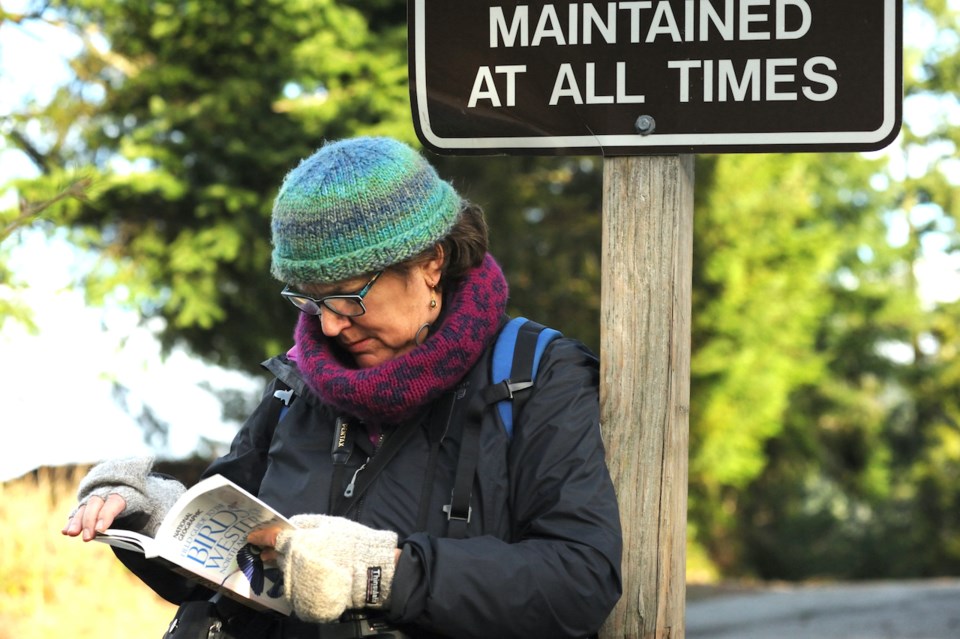The National Audubon Society’s 120th Christmas Bird Count took place from Dec. 14, 2019 through Jan. 5, 2020 with Bowen Island, which has been participating for more than 30 years, counting on Jan. 4. Thirty-three birders counted birds over much of the island on foot, by car, and by boat with the youngest members conducting their counts from the comfort of a stroller.
Of the data sheets currently returned, 46 different species were detected over the course of the day. In 2016 there were 77 species detected and 3,595 birds. In 2018, 60 species were detected and 1,818 birds. This year’s numbers aren’t all in yet.
The Christmas Bird Count (CBC) is a long-standing program of the National Audubon Society, with over 100 years of community science involvement. It is an early-winter bird census where thousands of volunteers across many Western Hemisphere countries go out over a 24-hour period to count birds. Volunteers count every bird they see or hear all day through a designated 15-mile (24-km) diameter. So, it’s not just a species tally—it’s a tally of all birds counted all day, giving an indication of the total number of birds in the circle that day!

If you’re interested in reviewing some of the historical data, it’s available online at audubon.org/conservation/where-have-all-birds-gone.
This data is becoming increasingly important as a recent study published in Science (September 2019) indicates that the North American bird population is down by 2.9 billion breeding adults since 1970, with devastating losses among birds in every biome. Common birds—the species that many people see every day—have suffered the greatest losses. More than 90 per cent of the losses (more than 2.5 billion birds) come from just 12 families including the sparrows, blackbirds, warblers, and finches. Forests alone have lost 1 billion birds. Grassland bird populations collectively have declined by 53 per cent, or another 720 million birds.
The study, which is titled “Decline of the North American Avifauna” is available online at birds.cornell.edu/home/bring-birds-back/.
In addition to recommending that people take part in bird counts to ensure timely data on bird populations, the Cornell website noted above provides other simple actions to help protect them:
Make windows safer, day and night.
By day, birds perceive reflections in glass as habitat they can fly into. By night, migratory birds drawn in by city lights are at high risk of colliding with buildings. On the outside of the window, install screens or break up reflections—using film, paint, or Acopian BirdSavers or other string spaced no more than two inches high or four inches wide.
Keep cats indoors or directly supervise them outside.
This is the number one human-caused reason for the loss of birds, aside from habitat loss. These nonnative predators instinctively hunt and kill birds even when well-fed.
Reduce lawn, plant native
Lawns and pavement don’t offer enough food or shelter for many birds and other wildlife.
Native plants add interest and beauty to your yard and neighborhood, and provide shelter and nesting areas for birds. The nectar, seeds, berries, and insects will sustain birds and diverse wildlife.
Avoid the use of pesticides
Pesticides that are toxic to birds can harm them directly through contact or if they eat contaminated seeds or prey. Pesticides can also harm birds indirectly by reducing the number of available insects which birds need to survive.
Drink coffee that’s good for birds
Shade-grown coffee preserves a forest canopy that helps migratory birds survive the winter.
Eliminate, at least reduce, the use of plastic
Avoid single-use plastics including bags, bottles, wraps, and disposable utensils. It’s far better to choose reusable items but if you do have disposable plastic, be sure to recycle it.
I would like to thank all the birders that took part in this year’s count. I would also like to extend special thanks to Brian Biddlecomb of Cormorant Marine who volunteered his boat and time to enable birders to count birds on Whorlcombe, Pasley and Ragged Islands. Gratitude also goes out to those property owners (such as Robin, my personal guide to Arbutus Bay and Eagle Tree Strata) that allowed birders to access their property to watch feeders, check in on significant bird habitat and otherwise enabled us to increase our count. As there is a specific methodology to the Christmas Bird Count, if you’d like to participate next year, feel free to contact me at 604.838.2321.



